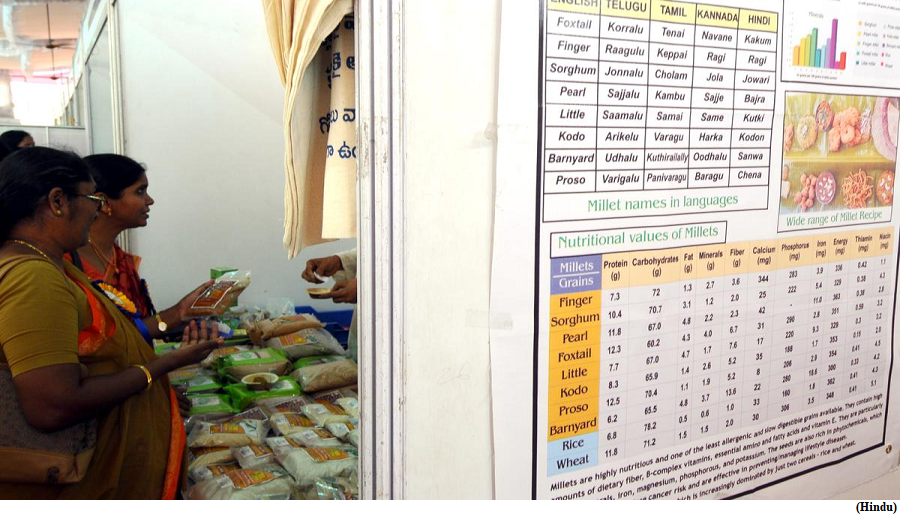An opportunity to recast India’s food system (GS Paper 3, Economy)

Context:
- No country can better understand the challenges of a food system than India, which feeds the largest population in the world.
- While the primary goal of a food system is to ensure nutrition security for all, it can only be achieved sustainably if the producers producing the food make reasonable economic returns that are resilient over time.
- This resilience is intricately linked with the resilience of our natural ecosystem because the largest inputs to agriculture; soil, water and climatic conditions are all but natural resources. Appreciating this interconnectedness of nutrition security with livelihood and environmental security is essential to making our food system truly sustainable.
Double burden of malnutrition:
- On the nutrition front, India faces a double burden of malnutrition. At one end, despite making great progress over the years, a sizable proportion of Indians exhibit nutrient deficiencies.
- As in the National Family Health Survey, 2019-21, 35% of children are stunted, and 57% of women and 25% of men are anaemic.
- At the other end, due to imbalanced diets and sedentary lifestyles, 24% of adult women and 23% of adult men are now obese. India has been stepping up efforts to reduce malnutrition, which has included even the Prime Minister calling for a mass movement to eradicate it.
Livelihood:
- On the production side, farm incomes are insufficient to meet the ends of marginal and small farmers. According to a report by the Transforming Rural India Foundation, more than 68% of marginal farmers supplement their incomes with non-farm activities.
- The Mahatma Gandhi National Rural Employment Guarantee Act (MGNREGA) and other forms of casual labour are picking up the slack, indicating a lack of skills or opportunities for income diversification.
Vulnerabilities:
- Further, depleting natural resources and changing climate are making India’s food production highly vulnerable. As in the 2023 soil health survey, almost half the cultivable land in India has become deficient in organic carbon, which is an essential indicator of soil health.
- Groundwater, the largest source of irrigation, is rapidly declining. In States such as Punjab, more than 75% of the groundwater assessment locations are over-exploited, threatening the resilience of farm incomes.
Adopt a three-sided approach:
- To solve these interconnected challenges, we need a triad approach that engages all three sides of the food system: consumers, producers, and middlemen.
Shift in consumer demand:
- The consumer demand needs to be shifted towards healthy and sustainable diets. There is need to shift to a food plate that is healthier for people and the planet. The private sector drives the aspirational consumption patterns for India’s billion-plus population.
- What corporations have done to mainstream imported oats or quinoa in India, can be done for locally-grown millets. Civil society and the health community could partner with social media influencers who can shape healthier and sustainable consumption for millions.
- Alongside, the public sector, through its innumerable touch points such as the Public Distribution System, mid-day meals, railways catering, urban canteens, and public and institutional procurement, can help improve what at least 70% of Indians are consuming.
- Even religious institutions can shape food choices. For instance, the Tirumala Tirupati Devasthanam, which serves nearly 70,000 people daily, has started procuring naturally-farmed produce.
Sustainable agriculture:
- To ensure resilient incomes, it is must to support farmers’ transition towards remunerative and regenerative agricultural practices. The National Mission on Natural Farming is a step in this direction, but the overall funding for sustainable agriculture is less than 1% of the agricultural budget.
- There is need to broaden and scale up such initiatives to various agro-ecological practices such as agroforestry, conservation agriculture, precision farming, and much more.
- Further, agriculture support should move from input subsidies to direct cash support to farmers per hectare of cultivation. It would promote efficient use of inputs, while enabling a level playing field for agroecological practices to thrive.
- Agricultural research and extension services should also earmark a proportion of their respective budgets to focus on sustainable agricultural practices.
Farm-to-fork value chains:
- A critical approach to enhance rural (farm) incomes is to enable more value addition of agricultural produce in rural areas.
- Middlemen, such as corporations supplying raw and processed food to consumers, should prioritise direct procurement from farmers, incentivise procurement of sustainably harvested produce, and implement well-established approaches such as fair trade.
- Various young agri-tech enterprises such as DeHaat and Ninjacart are enabling such farm-to-buyer linkages.
- Moreover, since all farmer families in a farmer producer organisation (FPO) are consumers of other farming goods, enabling trading of produce between FPOs is another way to ensure a greater value share for farmers, as showcased by a few FPOs in Odisha.
Way Forward:
- Shifting an entire food system, however, is no mean feat. But the scale of the challenge must not deter ambitions. India has a unique opportunity to showcase to the rest of the world how to get its food system right.


